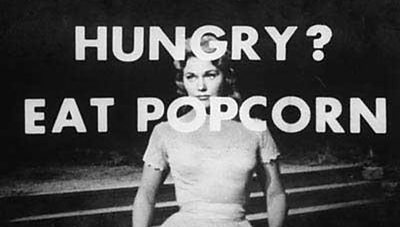
±«Óătv R&D were approached last year by Radio 4 documentary producer to help with a documentary he was putting together surrounding the myths and truths of subliminal advertising in video. In order to test the impact of subliminal message in video, an experiment was devised for the audience of the . This blog describes a brief background on subliminal advertising and the technical aspects of the experiment. The Radio 4 and the episode which accompanies the experiment are both available on iPlayer for your listening pleasure. For more information, see .
What is subliminal advertising?
Subliminal messaging was first popularised by the infamous âEat Popcornâ experiments in 1956. The aim of subliminal messages in video is to briefly flash a message on top of a video for such a short time that they donât appear visible, with the intention of influencing a personâs decision. In this first âfield trialâ, James Vicary claimed to have increased sales of popcorn by 57.7% and sales of Coca-Cola by 18.1% by flashing unnoticeable messages reading âEat Popcornâ and âDrink Cokeâ during big screen movies. With little evidence, other than the results shown by Vicary, mass panic ensued around the world, with the UN proclaiming âthe cultural implications of subliminal indoctrination is a major threat to human rights throughout the worldâ
Several years later, during an interview with the trade paper Advertising Age, James Vicary confessed that âwe hadnât done any research, except what was needed for filing a patent. I had onlyâŠa small amount of data â too small to be meaningful. And what we had shouldnât have been used promotionally.â However, the strict control and use of subliminal messaging throughout the world still exists.
In the ±«Óătv Radio 4 documentary, presenter David Aaronovitch will dispel the myths and misinformation surrounding subliminal and explore the scientific theories about subliminal influence. In recent times, subliminal messaging has been shown to work, but only when performed in the strictest of lab conditions. In a controlled study by , participants were asked to choose whether a word that appeared subliminally was positive, negative or neutral; the authors claim that the participants responded more accurately to . Work by Professors Karremans and Stroebe from the in Holland have repeatedly shown that subliminal advertising does work, again only under the strictest of lab conditions. Can this result be transferred to a public venue?
The Equipment and Video
Under the guidance of Professor Stroebe, Radio 4 producer Phil Tinline and ±«Óătv R&D developed a test in which the unknowing audience of the Infinite Monkey Cage could be subjected to subliminal messages and if their decisions could be swayed one way or another.
According to Professor Stroebe, one of the most important aspects of a subliminal experiment is not only that the hidden messages remain hidden, but that those participating in the experiment do not know that what they are watching contains subliminals. If the audience members are aware of the existence of the messages, they are likely to be completely ineffective. So we asked members of the Infinite Monkey Cage audience to volunteer to take part in an experiment, making clear that we couldnât reveal the nature of the test until afterwards.
So when they sat down to watch the clip containing the subliminals, they knew they were taking part in an experiment â just not what it was testing.
To generate the hidden messages, there are a number of factors that can be varied when inserting the hidden message into the video: the duration of the message, how often the message is displayed and how visible is the message.
After some initial experimentation in the lab, it was decided that the video on which the subliminal would be shown would have to contain lots of activity and motion. This is because, for the messages to be rendered consciously invisible, they need to be âmaskedâ. In the lab, this can be done by flashing a meaningless arrangement of letters immediately after the message. This would be impossible to do within a video clip, but we were advised that a clip full of rapid camera-work and quick edits should work instead. The fast paced ±«Óătv drama , produced by , was chosen for this test.
For the frequency of the message, we decided to follow Stroebeâs lead, and the message of choice was to be repeated every 5 seconds. The visibility of the message was chosen so that the message was not overly obvious or distracting. A good balance was struck between font size (100pt), colour (50% grey) and transparency (10%). It was decided that the message should be perfectly readable on a still frame.
The final factor of how long the subliminal should remain on the screen was the trickiest to evaluate. A typical TV screen or projector can usually only refresh at 50fps (ignoring any internal processing or upconversion that a television might do). This would give a minimum subliminal duration of 20 milliseconds (ms). It became apparent during these tests that this duration was not going to be short enough for the subliminal to remain largely unnoticeable. This is where ±«Óătv R&D expertise on High Frame Rate (HFR) television came in.
±«Óătv R&D are exploring various aspects of a future broadcasting system, and is one aspect that is currently being explored. HFR is being researched as a way that could provide more accurate and immersive video to audiences, but the technique also helped the team find an optimal frame rate per second (fps) for our experiment. Using specialist HFR monitors, it was found that running a screen at 100fps, a subliminal screen time of 10ms, gave a much better response.
The Experiment
Armed with the equipment, a unique experiment was setup for the unknowing audience of the Infinite Monkey Cage. A cinema type environment was set up during the recording of the Monkey Cage episode at the Studios in central London. A projector, capable of showing HD video at 100fps, was used for the cinema projection. Almost 100 volunteers were divided up into a test group and a control group. Each group were shown a three minute clip of Spooks, however the test group were shown a video that contained the subliminal message, while the control groups video contained no secret messages. The message that was chosen was âLiptonâ. A still frame of the message is shown below.
Subliminal Still Image(Courtesy of Kudos)
After the clips, the volunteers were then offered a choice of two drinks â a bottle of Lipton, or a mineral water. We chose to use Lipton Iced Tea for specific reasons. Following Professor Stroebeâs guidance, we conducted a series of pre-test surveys to identify a brand that would meet the criteria he had found needed to apply for the subliminal messages to be effective in lab conditions. These were, first, that the brand was reasonably familiar, but not generally a habitual choice, and, second, that it needed to be seen as thirst-quenching. On the basis of our pre-tests, Lipton Iced Tea seemed to fit these criteria well; as it was also the brand that Professor Stroebe had chosen to use, on the same basis, the case for using this brand seemed strong.
Each audience member were then presented with a series of questions, which included ones regarding their strong like or dislike of beverages, in order to gauge their preferences towards Lipton Ice Tea, and their drink of choice was noted. The results were then analysed and presented during the live recording of the Infinite Monkey Cage.
Did it work?
As suggested earlier in this blog, subliminal messaging has been shown to work, under very strict lab conditions. Stroebe has shown in his experiment that the decision of a thirsty person could be swayed with the use of subliminal, providing they had a neutral feeling towards the product they were choosing, i.e. they do not either hate or love the drink in the subliminal. To make our audience thirsty, we provided salty snacks prior to the showing of the video clips.
So, did our experiment work? You will have to listen in to the and the to find out!
Thanks
±«Óătv R&D would again like to thank for their help in this project, for their technical assistance on the day of recording, and to ±«Óătv producer Phil Tinline for providing R&D with an interesting problem to work on in our spare time.
